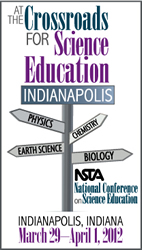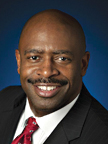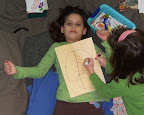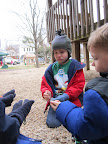Front-Page Science: Engaging Teens in Science Literacy
—From Chapter 1 of Front-Page Science
—From Chapter 1 of Front-Page Science
By Mary Bigelow
Posted on 2012-01-28
 Are you attending the NSTA conference in Indianapolis this spring? At this point, you should be registering, making arrangements for lodging and transportation, and thinking about your lesson plans for the substitute (if you haven’t done so already).
Are you attending the NSTA conference in Indianapolis this spring? At this point, you should be registering, making arrangements for lodging and transportation, and thinking about your lesson plans for the substitute (if you haven’t done so already).
If this the first time you’ve attended the national conference, it can be overwhelming at first. Here are some suggestions, updated from last year’s blog:
Consider attending the first-timers session on the first day. This year, Dr. Christine Royce is hosting the session Conference Tips for First-Timers on Thursday, March 29 3:30–4:30 PM in the JW Marriott Indianapolis, JW Grand Ballroom 5. It’s worth the time.
There are a few other things you should do before you go:
Read more suggestions on what to take and what to do.

Some hints on what to take:
At the Conference:
Back Home:
Does anybody else have tips for conference newbies? Please leave a comment.
Update: 2012.08.21
NSTA has created these “infographics” to help you maximize your conference experience—click on an image to open a full-sized PDF:
 Are you attending the NSTA conference in Indianapolis this spring? At this point, you should be registering, making arrangements for
Are you attending the NSTA conference in Indianapolis this spring? At this point, you should be registering, making arrangements for
By Peggy Ashbrook
Posted on 2012-01-27
 I am so looking forward to the NSTA national conference in Indianapolis in March 2012! It’s not that I’m tired of my everyday life and teaching work—it’s that I’m eager to be back from the conference with fresh ideas and new connections to create in the curriculum. NSTA conferences are joyful events, populated with educators doing what they love best.
I am so looking forward to the NSTA national conference in Indianapolis in March 2012! It’s not that I’m tired of my everyday life and teaching work—it’s that I’m eager to be back from the conference with fresh ideas and new connections to create in the curriculum. NSTA conferences are joyful events, populated with educators doing what they love best.
I want to:
 share my ideas on making connections between indoor and outdoor activities to draw students and teachers outdoors (Friday March 30, 11:00 AM–12:00 PM, Outdoor–Indoor Connections to Beguile Your Students into a Love of Nature, Chamber, Westin Indianapolis).
share my ideas on making connections between indoor and outdoor activities to draw students and teachers outdoors (Friday March 30, 11:00 AM–12:00 PM, Outdoor–Indoor Connections to Beguile Your Students into a Love of Nature, Chamber, Westin Indianapolis). All of us who count astronauts as role-models can look forward to hearing NASA’s Associate Administrator for Education, Leland Melvin, speak on “Inspiring the Next Generation of STEM Leaders” (Thursday March 29, 9-10am, Indiana Convention Center, Sagamore Ballroom).
All of us who count astronauts as role-models can look forward to hearing NASA’s Associate Administrator for Education, Leland Melvin, speak on “Inspiring the Next Generation of STEM Leaders” (Thursday March 29, 9-10am, Indiana Convention Center, Sagamore Ballroom).
The NSTA Learning Center has a Professional Development Community Forum discussion going on with tips for attending conferences. Here are some of the ideas contributed by veteran conference-goers:
Tina Harris: Take your own flat-rate postal boxes and tape with you so you can pack and ship as you accumulate give-aways and purchases. 3 flat rate boxes = $50 extra suitcase and you don’t have to lug it through an airport! We here in Indy are also offering some wonderful field trips (check the conference schedule).
Carolyn Mohr: The exhibitors’ hall is not ‘doable’ in one day. Some socials provide free treats and beverages and you get a chance to mingle with like-minded teachers.
Susanne Hokkanen: I recommend at least two workshops at each time slot, because sometimes workshops fill up fast, and your first choice may not be available or open or may be too far away to reach in time. And try to leave a time slot open just for “absorb it all” time.
Laura Jones: I also would recommend the most comfortable shoes you have.
Ms. Mentor suggests visiting the Conference Newcomers’ Page. She made some recommendations for the 2011 conference which apply to area and national conferences in any year, such as, Introduce yourself to teachers at the sessions or events. You’ll meet lots of interesting people and make many new personal connections.
I hope to meet some of you in Indianapolis or at another conference. You can register online now, and the early bird price is good through February 3. My wishful-thinking schedule has three (gulp!) sessions for each time slot—guess I’d better re-evaluate the list and look for a slot to “absorb it all”—wait, isn’t that what the plane trip home is for!?
Peggy
 I am so looking forward to the NSTA national conference in Indianapolis in March 2012! It’s not that I’m tired of my everyday life and teaching work—it’s that I’m eager to be back from the conference with fresh ideas and new connections to create in the curriculum.
I am so looking forward to the NSTA national conference in Indianapolis in March 2012! It’s not that I’m tired of my everyday life and teaching work—it’s that I’m eager to be back from the conference with fresh ideas and new connections to create in the curriculum.
By Mary Bigelow
Posted on 2012-01-26
 Our school is facing a budget crunch. Each department was asked for suggestions for cost-saving measures. Do you have any suggestions the science department can add to the list?
Our school is facing a budget crunch. Each department was asked for suggestions for cost-saving measures. Do you have any suggestions the science department can add to the list?
— Brenda, New York
It’s heartbreaking (or outrageous, depending on one’s point of view) to see teachers and administrators expected to provide more services with fewer financial resources. I know of several public schools that are even asking parents to donate classroom supplies. This imposes a burden, especially in times when many families also are struggling at home. I’m sure you and your colleagues are thrifty, but I’ve talked with some colleagues for suggestions to supplement your efforts.
Paper and copying can be a place to scale back.
Ask students for suggestions! They may come up with some good ideas that give them ownership in the process. (Keep your sense of humor—my students had suggestions such as Save paper with shorter tests or Save water by not making us wash our hands before lunch.)
Professional development (PD) often is on the budget chopping block, but it’s more important than ever. Rather than listing a series of unrelated events, be sure your activities all connect with your identified goals. Suggest PD activities that are free or have minimal costs: teacher-directed study groups, blogging, action research projects, independent study, presentations by your own teachers, online courses (such as those offered by NSTA), events at nearby museums or science centers, and online collaborations via discussion groups, tweetchats, videoconferencing, or networking sites.
None of these suggestions will save huge amounts of money. However, many of the suggestions may also lead to greener classrooms with less waste.
For more ideas:
Science on a Shoestring—The Science Teacher, July 2011
Professional Development—Science & Children, July 2010
Professional Development on a Shoestring – Ms Mentor, March 2009
NSTA’s Frugal Science Teacher books
Photo: http://www.flickr.com/photos/68751915@N05/6736170827/sizes/l/in/photostream/
 Our school is facing a budget crunch. Each department was asked for suggestions for cost-saving measures. Do you have any suggestions the science department can add to the list?
Our school is facing a budget crunch. Each department was asked for suggestions for cost-saving measures. Do you have any suggestions the science department can add to the list?
— Brenda, New York
By Martin Horejsi
Posted on 2012-01-24
One year ago, this blog highlighted the unique opportunity of the Google’s Global Online Science Fair. Well, the fair was a success and the winners have been announced. According to a Google website, Over 10,000 students from 91 countries submitted amazing science experiments. With project topics ranging from “Can I program a robot in English?” to “Can I make a sailboat even faster with a winged keel,” to “How does marinade affect carcinogen levels in grilled chicken?,” we were fascinated, inspired and awed by the young scientific talent across so many fields all over the world.”
The winners are:
And here is an inspiring YouTube video of the winners describing their experiences and experiments.
[youtube]http://www.youtube.com/watch?v=fmnAFj4Y3tc[/youtube]
And for those ready to take the plunge in 2012, here’s the promo video inviting participation. Submissions are being accepted on the site until March 30, and regional finalists will be chosen in May, and 15 finalists will be selected in June. The winners will be announced at Google’s headquarters on July 23, 2012.
How to enter? Watch the video below.
[youtube]http://www.youtube.com/watch?v=sElBwQkK4mE&feature=player_embedded#![/youtube]
One year ago, this blog highlighted the unique opportunity of the Google’s Global Online Science Fair. Well, the fair was a success and the winners have been announced. According to a Google website, Over 10,000 students from 91 countries submitted amazing science experiments.
By Mary Bigelow
Posted on 2012-01-21
By Mary Bigelow
Posted on 2012-01-18
By Teshia Birts, CAE
Posted on 2012-01-16
Having worked with small organizations for a number of years now, inevitably I will hear one state chapter or component leader say, “We don’t have to worry about filing taxes…we didn’t have enough income.”
Well, this is partly true. Your organization may not need to file a formal 990, but you will have to file something, regardless of how small the revenue. Organizations with revenues beyond $50,000 must complete an IRS Form 990 or 990 EZ, but if the organization’s revenue is $50,000 or less ($25,000 or less for tax years after December 31, 2007 and before December 31, 2010) a Form 990-N (postcard) must be filed.
The 990-N is an electronic postcard and is simple to complete. You only need to complete eight basic items of information: (1) EIN or TIN; (2) Tax Year; (3) Legal name of organization and mailing address; (4) Any other aliases or names of the organization; (5) Name and address of principal officer; (6) Organization website address; (7) Confirmation that the organization’s annual gross revenue are $25,000 or less ($50,000 or less for tax years after December 31, 2010), and (8) If applicable, a statement that the organization has gone out of business.
The trickiest issue is trying to figure out WHEN to file your organization’s 990, 990EZ or 990-N – always remember five and 15th. Your organization’s tax filings are due the fifteenth day (just like our individual tax returns) of the fifth month after the end of your fiscal year. For example, if the last day of your fiscal year is June 30th, your organization’s tax filings are due November 15th. I always suggest that organization leaders/staff add this date to their operational timeline and policy and procedure manual.
For more information about the 990-N, visit Annual Electronic Filing For Small Exempt Organizations.
By Peggy Ashbrook
Posted on 2012-01-14
There is nothing like a family illness for making the point that it is important for the average person to have a basic understanding of science concepts. Several recent hospitalizations among family and friends have made me aware of how much there is for me to learn about medical science and engineering, even though I feel I have a good (but not advanced) understanding of physics, chemistry, biology and earth science, and some engineering. There are always choices for the patient and family to make, alternatives to weigh, and procedures to follow for better health. Some of those require us to understand what the blood tests are measuring, how blood pressure affects the body, which Continuous Positive Airway Pressure breathing mask to choose, and how medications work.
 Like imaginative play about Space, children enjoy pretending to be medical personnel, taking temperatures, looking at or drawing x-rays, and applying band-aides. This imaginative play supports childrens’ developing science understanding and an interest in learning more. Children’s play allows them to make beginning theories about how the world works. Undirected play also allows teachers to assess academic and social skills to see what we need to focus on in coming weeks.
Like imaginative play about Space, children enjoy pretending to be medical personnel, taking temperatures, looking at or drawing x-rays, and applying band-aides. This imaginative play supports childrens’ developing science understanding and an interest in learning more. Children’s play allows them to make beginning theories about how the world works. Undirected play also allows teachers to assess academic and social skills to see what we need to focus on in coming weeks.
After observing the children’s undirected play I ask myself, What materials can I add to the room to spur the students to extend their play using practices which will support their later learning in science and engineering? What group discussions will support students in the science and engineering practices of asking questions and defining problems, developing and using models, planning and carrying out investigations, analyzing and interpreting data, using mathematics and computational thinking, constructing explanations and designing solutions, engaging in argument from evidence, and obtaining, evaluating, and communicating information in unstructured and structured activities? What structured activities will focus on the concepts they appear to be exploring? And, how will all of this fit into the standards and curriculum of my program?
One example is the frequent math play I see the three and four-year-olds doing with manipulatives and their snack items. They are trying out, on their own, the concepts they’ve been working on with teachers and through their observations of the world. For the math-exploring young five, I might introduce the idea of using a Venn Diagram when grouping, by offering two hoops to define the groups. For the snack-sorter who is demonstrating a strong interest in one-to-one correspondence, I might ask “How are these objects the same and how are they different?” and “How many do you have all together?”

Another example of how science concepts can be explored during undirected play is learning about the friction (or lack of) between winter mittens and the playground sliding pole as compared to the friction between bare hands and the metal of the pole. When a child went down too fast for his comfort, I was able to have him compare a bare hand to a mitten-covered hand on the pole—a short experience and discussion about the nature of materials.
These small moments are positive steps towards building scientific literacy.
Peggy
There is nothing like a family illness for making the point that it is important for the average person to have a basic understanding of science concepts. Several recent hospitalizations among family and friends have made me aware of how much there is for me to learn about medical science and engineering, even though I feel I have a good (but not advanced) understanding of physics, chemistry, biology and earth science, and some engineering. There are always choices for the patient and family to make, alternatives to weigh, and procedures to follow for better health.